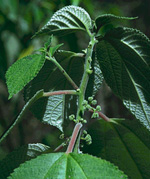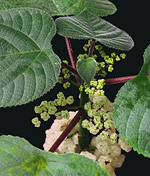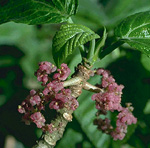 |
This is a widely distributed family, most diverse in the tropics but with some genera (especially Urtica) extending into temperate and cold regions of both hemispheres. In Australia, most genera occur in rainforests and other wet forests along the east coast, but Urtica and Parietaria are widespread over much of Australia in moist, shaded sites.
Characteristic features of the family Urticaceae in Australia include:
- trees, shrubs or herbs with alternate, simple, usually toothed leaves
which are often 3-nerved from the base, some with stinging hairs
- flowers small, greenish, unisexual, usually borne in dense, axillary
clusters, usually with 3-5 perianth parts
- male flowers with 3–5 stamens adjacent to the perianth parts,
female flowers with a superior ovary and sessile stigma, and the perianth
often vestigial
- fruit a small, dry nut, rarely a fleshy drupe
Description
Evergreen trees, or shrubs, or woody vines climbing by twining or scrambling stems, or annual or perennial terrestrial herbs, or epiphytes. Perennating by rhizomes. Vegetative reproduction absent, or by rhizomes. Stem internodes solid, or spongy, or pithy, or hollow, terete or distinctly angular. Internal secretions not obvious. Plants glabrous, or with stinging hairs present or absent, or with simple, non-glandular, unicellular hairs. Leaves alternate and spiral, or distichous, or opposite, cauline if herbs, petiolate, subsessile or sessile, or peltate. Stipules rarely absent, distinct and free from the petiole or interpetiolar, scale-like, or membranous, or green and leafy, or bristle-like, falling off early. Lamina simple, symmetric or conspicuously asymmetric, lanceolate, ovate, elliptic, oblanceolate, obovate or oblong; base cuneate, rounded, cordate, lobed, auriculate or oblique; margins entire, crenate, dentate, serrate or sinuate, ±flat; venation pinnate, or parallel, with the midrib conspicuous, and the tertiary venation reticulate or not; surfaces not punctate; herbaceous, leathery or membranous or papery. Domatia present. Male and female flowers occurring on the same plant or on separate plants, or rarely with all the flowers bisexual. Inflorescences axillary, consisting of capitula, spikes or panicles. Bracts present or absent. Pollination by wind. Flowers odourless, sessile or stalked. Perianth regular, or rarely irregular, of 1 whorl only, or vestigial, with 3–5 free or fused sepaloid segments, or absent, imbricate or valvate in bud, bell-shaped or urn-shaped, herbaceous. Fertile stamens 3–5, opposite to and free of the perianth, free of the ovary and style, distinct from each other, all ±equal. Staminodes present or absent. Anthers dorsifixed, not versatile, opening inwards by longitudinal slits, 2-celled. Ovary superior and sessile. Carpel 1; ovary with 1 locule. Style absent and the stigma terminal and ±sessile on the ovary. Ovule 1, sessile; placentation basal. Fruit a dry indehiscent achene; the perianth on the maturing fruit dry and persistent, or growing larger. Disseminule micro-surface ±muricate or tuberculate, brown, dull. Seed 1 per fruit. Aril absent. Cotyledons 2. Embryo straight.
(Note: this description has been generated from the coded data compiled for the key. Any errors in the key data will be reflected in the descriptions.)
A treatment of the family Urticaceae has been published in:
Flora of Australia 3: 68-93.
Australian genera of Urticaceae (as recognised for the Flora of Australia)
† = some species native, others introduced
* = all species introduced
Australina
Boehmeria
Dendrocnide
Elatostema
Laportea
†Parietaria
*Pilea
Pipturus
Pouzolzia
*Soleirolia
†Urtica

|
  |

Boehmeria australis (flowers)
Photo: M.Fagg © ANBG

Boemeria nivea (flowering branch)
Photo: H.Nicholson © H. & N. Nicholson

Dendrocnide cordata (flowers)
Photo: M.Fagg © M.Fagg

Dendrocnide excelsa (fruits)
Photo: M.Fagg © ANBG

|
 |
|